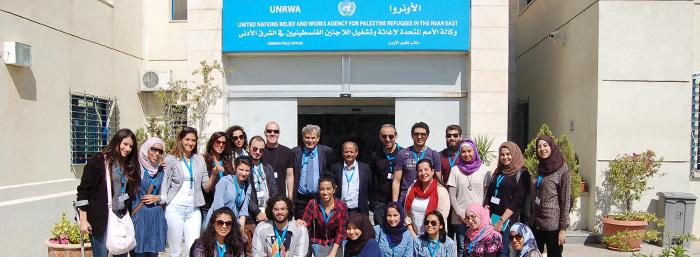- About
- Admissions
- Study at AUS
- Prospective Students
- Bachelor's Degrees
- Master's Degrees
- Doctoral Degrees
- Admission Publications
- International Students
- Contact Admissions
- Grants and Scholarships
- Sponsorship Liaison Services
- Testing Center
- New Undergraduate Student Guide
- Undergraduate Orientation
- New Graduate Student Guide
- Graduate Orientation
- File Completion
- Payment Guide
- Students with Disabilities
- Executive and Continuing Education
- Academics
- Life at AUS
- Research
- Publications
- Contact Us
- Apply Now
- .

CAAD students visit Jordan
Eleven fourth- and fifth-year architecture students from the College of Architecture, Art and Design (CAAD) at American University of Sharjah (AUS), accompanied by professors Michael Hughes, Maria Mortera and George Katodrytis, travelled to Amman, Jordan October 14-18, 2014. The purpose of the trip was to visit the Jordan Field Office of UNRWA (United Nations Relief and Works Agency for Palestine Refugees in the Near East) and the Jerash Palestinian Refugee camp, which is the site for the design of a series of projects currently developed at the architecture studios of CAAD in collaboration with UNRWA.
While there, the visiting group met with UNRWA officials in the Jordan Field Office, who presented their work in the camp. This was followed by a visit to the camp, where the students visited sites including shelters, the market, the school, the clinic and the site for a future bus stop.
"Design is a powerful tool for social justice. Our studio aimed to introduce architecture students to research opportunities grounded in community-based outreach projects inspired by engagement with real people," said Hughes, who is Head of the Department of Architecture at CAAD.
According to architecture student Nasser Mohamed Alzayani, "Intended as a visit that would help us gain some insight into the physicality of the refugee camp we are working on in studio, the trip to Amman not only provided us with an opportunity to collect valuable first-hand information, but it also offered a unique cultural experience. Seeing refugee camps, Roman ruins and modern architecture helped us familiarize ourselves with the many sides of Jordan. There was time to work and time to learn, time to explore and time to relax."
"Currently more than 30,000 Palestinian refugees live in the Jerash camp of 0.75 square kilometers, an area smaller than the AUS campus," said Katodrytis, Associate Professor of Architecture. "Our design studio introduced ideas and architectural proposals of various scales to improve the living conditions of this overcrowded camp-city. We plan to construct a number of these urban interventions."
The Jerash camp was set up as an emergency camp in 1968 for 12,000 Palestinian refugees and displaced persons who left the Gaza Strip as a result of the 1967 war and the occupation of Palestine. It is known locally as Gaza camp. After 1967, UNRWA quickly set up facilities for food aid, sanitation, health services and education. In order to withstand the harsh winters, the original 1,500 tents were replaced with prefabricated shelters. Between 1968 and 1971, 2,000 shelters were built with support from emergency donations. Over the years, many of the camp's inhabitants have replaced the prefabs with more durable concrete shelters. Many roofs are still made of corrugated zinc and asbestos sheets.

